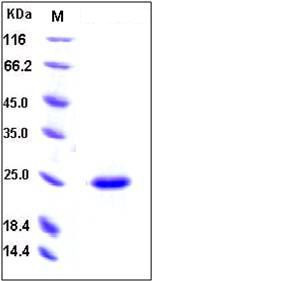Human SDF2 Protein (His Tag)
SDF2
- 100ug (NPP4249) Please inquiry
| Catalog Number | P10950-H08B |
|---|---|
| Organism Species | Human |
| Host | Baculovirus-Insect Cells |
| Synonyms | SDF2 |
| Molecular Weight | The recombinant human SDF2 consists of 204 amino acids after removal of the signal peptide and has a predicted molecular mass of 22.7 kDa. also estimated by SDS-PAGE under reducing conditions due to glycosylation. |
| predicted N | Ser 19 |
| SDS-PAGE |  |
| Purity | > 95 % as determined by SDS-PAGE |
| Protein Construction | A DNA sequence encoding the pro form of human SDF2 (NP_008854.2) (Met 1-Leu 211) was expressed with a C-terminal polyhistidine tag. |
| Bio-activity | |
| Research Area | Immunology |Signal Transduction |Metabolism |Amino Acids |
| Formulation | Lyophilized from sterile 50mM Tris, 100mM NaCl, pH 8.0, 0.5mM PMSF, 0.5mM EDTA, 0.5mM TCEP, 10% glycerol 1. Normally 5 % - 8 % trehalose, mannitol and 0.01% Tween80 are added as protectants before lyophilization. Specific concentrations are included in the hardcopy of COA. |
| Background | Stromal derived factors (SDFs) are a loosely defined group of molecules that are generated by stromal cells. Two of the stromal derived factors, SDF-1 and SDF-4 belong to the chemokine family. Other SDFs, such as SDF-2 and SDF-5 are not well defined and their biological functions are less known. SDF-2 is first isolated from the mouse stromal cell line ST2 as a secretory protein. The amino acid sequence deduced from the murine clone and the human homolog are conserved more than 92 %, and the aa sequence of SDF-2 shows similarity to those of yeast dolichyl phosphate-D-mannose, protein mannosyltransferases. SDF-1 and its receptor are strongly indicated in the progression of various cancers including breast cancer. SDF-2, SDF2-L1, SDF-4, and SDF-5 are ubiquitously expressed in various cancer cell lines and SDF-2, SDF-4 and SDF-5 are expressed in mammary tissues. These SDFs have prognostic value and warrant further investigation in their biological functions and clinical value. |
| Reference |
